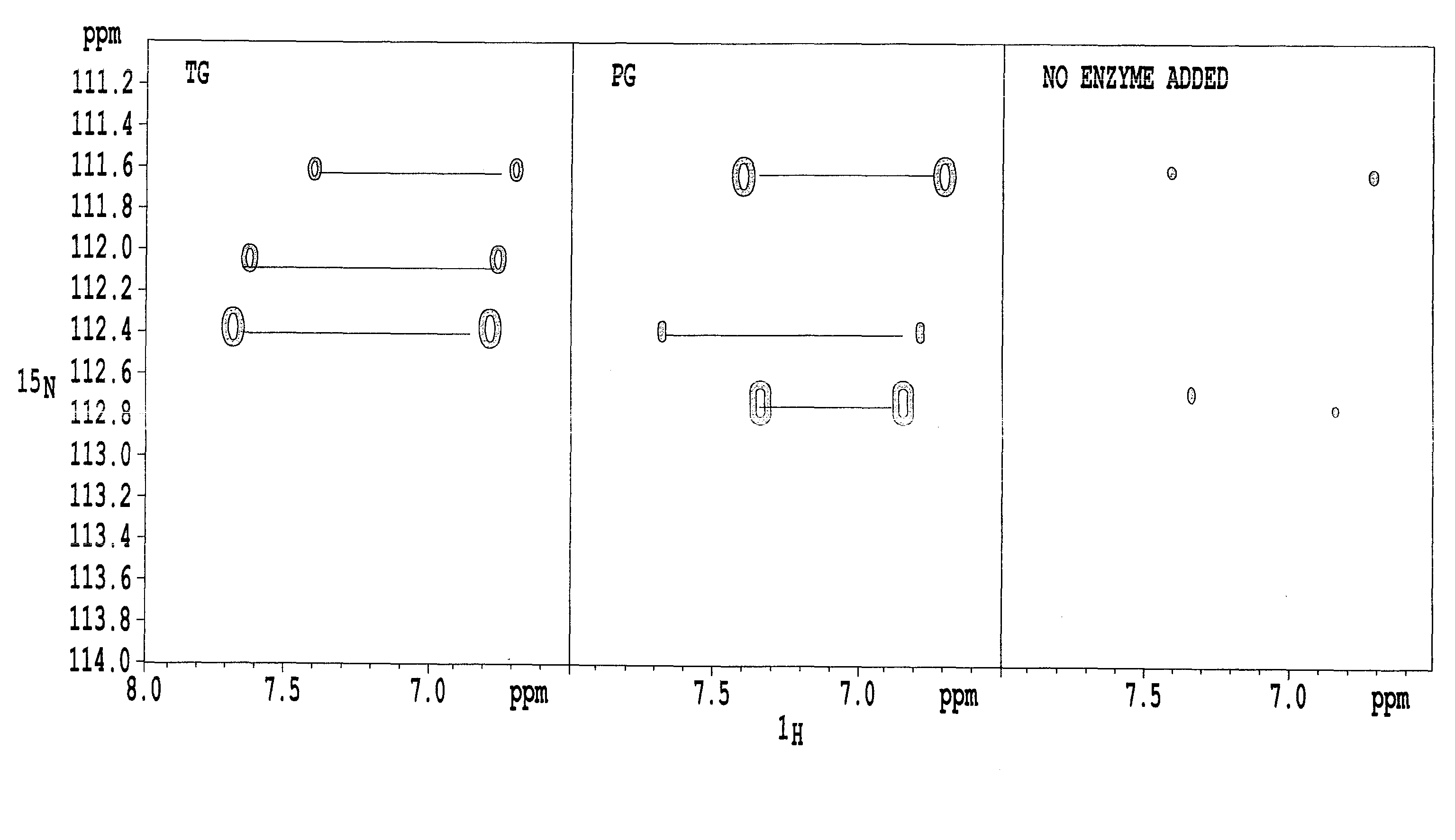Method of denaturing protein with enzymes
- Summary
- Abstract
- Description
- Claims
- Application Information
AI Technical Summary
Benefits of technology
Problems solved by technology
Method used
Image
Examples
experimental example 1
[0059]An α-lactalbumin (referred to as “α-La” hereinafter) (Sigma) was used as a substrate. A solution of the substrate (10 mg / ml of α-La, 200 ml of 15NH4Cl, 5% D2O / 20 mM Tris-HCl (pH 7.0)) was prepared and then TG (purified enzyme from “Activa” TG, Ajinomoto Co., Inc.) or PG (prepared from Chryseobacterium described in Patent Document 1) was added such that a ratio of substrate to enzyme of 1000:1 was achieved. The mixture was incubated for 26.5 hours at 37° C. The incubated solution was poured into an NMR sample tube and 1H-15N HSQC was measured using NMR (Avance 600, Bruker Corporation). The result of the 1H-15N HSQC measurement after 26.5 hours is shown in FIG. 1.
[0060]When carboxyamide nitrogen is replaced with 15N, two signals are observed as a pair per one chemical shift of 15N because two atoms of 1H are bonded with the 15N. It can be seen that a part of nitrogen atoms of carboxyamides of glutamine residues in α-La is labeled with 15N and succeeded in exhibiting 15N labeling...
example 1
[0061]TG or PG as explained in Experimental Example 1 was added independently to a milk on the market, 0.2 M 15NH4Cl and 5% D2O, and signal intensity at each added concentration was measured. TG was added such that a ratio of substrate to enzyme (S / E ratio) was 7400 / 1 by weight. On the other hand, PG was added by 0.002 to 5 times of TG by weight. A relative activity of the TG was 26 units per 1 mg of enzyme protein and a relative activity of the PG was 120 units per 1 mg of enzyme protein. The solution containing the enzyme was then incubated for 3 hours at 37° C., and then poured into an NMR sample tube and measured by 1H-15N HSQC using NMR described in Experimental Example 1. The amount of added PG was indicated by weight ratio (PG / TG) of enzymes and activity ratio (PG / TG) against the amount of TG added. Signal intensity ratio (PG / TG) corresponding to each ratio is shown in Table 1.
TABLE 1SignalWeight ratiointensityof enzymesActivity ratioSignalratioTGPG(PG / TG)(PG / TG)intensity(PG / ...
example 2
[0068]Skim milk powder (low heat-type, milk protein 35%, Yotsuba Co., Ltd.) was added by 0.85% to Takanashi Milk Products Co. Ltd.'s low fat milk (milk protein 3.3%, milk fat 1.0%) to adjust the milk protein concentration to 3.6% and dissolved at 55 degrees C. by heating to prepare raw material milk for yoghurt. The raw material milk was heated in a boiling bath, kept in two minutes after reached 95° C. and then cooled in an ice bath immediately. When the raw material milk reached 47° C., a lactic acid bacteria starter (Yo-Flex, DVS YC-370, Christian Hansen) was added by 0.006%, and TG and PG were added according to Table 5 and stirred well. Then it was divided into plastic cups by specified amount and fermented in an incubator at 44° C. until the pH reached 4.5 to 4.6. It took approximately 4 to 5 hours from the beginning to the end of fermentation. After fermentation, the products were preserved in a refrigerator at 5° C. Next day, an amount of syneresis on the surface of the obta...
PUM
| Property | Measurement | Unit |
|---|---|---|
| Force | aaaaa | aaaaa |
| Mass | aaaaa | aaaaa |
| Mass | aaaaa | aaaaa |
Abstract
Description
Claims
Application Information
 Login to View More
Login to View More - R&D
- Intellectual Property
- Life Sciences
- Materials
- Tech Scout
- Unparalleled Data Quality
- Higher Quality Content
- 60% Fewer Hallucinations
Browse by: Latest US Patents, China's latest patents, Technical Efficacy Thesaurus, Application Domain, Technology Topic, Popular Technical Reports.
© 2025 PatSnap. All rights reserved.Legal|Privacy policy|Modern Slavery Act Transparency Statement|Sitemap|About US| Contact US: help@patsnap.com


